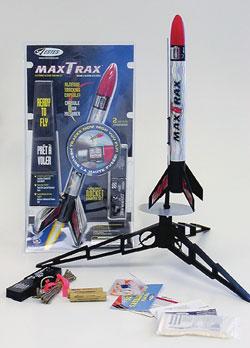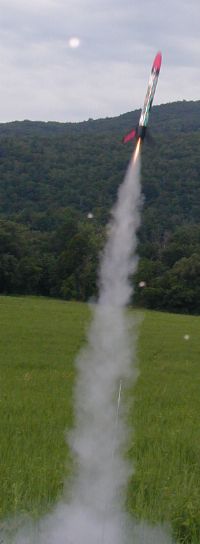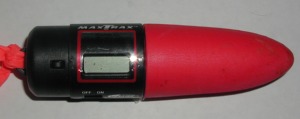| Construction Rating: | starstarstarstarstar |
| Flight Rating: | starstarstar_borderstar_borderstar_border |
| Overall Rating: | starstarstarstar_borderstar_border |
| Published: | 2010-08-10 |
| Manufacturer: | Estes  |
I saw a thread on RMR about a new Estes' rocket with the capability to determine altitude. I decided to purchase one from the local Walmart. It is a Ready to Fly rocket (for all practical purposes) included with a starter set. Launch pad, controller and two motors (B6-4 and C6-5). The rocket is called the MaxTrax™. Walmart sold it for $18.99. You have to purchase a "button" battery for the nose cone and the (4) four AA batteries for the launch controller separately.
THE LAUNCH EQUIPMENT:
 Not much to say here as it is Estes' standard stuff. The pad assembles easily by sliding the three legs into the base slots. The rod comes in two pieces and has to be "bounced" together. The rod, stand-off and deflector plate then go into the 1/8" slot. It has an adjustable tilt with a wing nut to loosen or tighten as needed.
Not much to say here as it is Estes' standard stuff. The pad assembles easily by sliding the three legs into the base slots. The rod comes in two pieces and has to be "bounced" together. The rod, stand-off and deflector plate then go into the 1/8" slot. It has an adjustable tilt with a wing nut to loosen or tighten as needed.
The launch controller is a black plastic box with a place to insert a safety key which lights a bulb indicating continuity. The safety key has a feature which is nice. It must be pushed in to be active. If you let your finger off, it springs back breaking continuity. Nice safety add. By pressing the safety key and then the launch button the rocket is ignited. The 15' wire runs from the launch controller to the launch pad and attached to the ignitors with two "toothless" alligator clips.
THE ROCKET:
The rocket is Ready-to-Fly after you tie the pre-assembled parachute to the elastic shock cord. You also need to put the battery into the nose cone MaxTrax™ Electronic Capsule. You will need a small Phillips-head screw drive to do that.
The rocket has fairly nice looks. It has a black plastic fin can with 4 fins and a motor retention ring. The ring is a twist-lock type that holds the motor in place during flight. The 1.35" (BT56) body tube is covered with a holographic looking silver paper with MaxTrax™ displayed on the side. The nose cone has a black section and a removable red foam covering. Not bad over all.
Overall, for CONSTRUCTION I would rate this kit 5 points . After all, it would be hard to be anything else.
 FLIGHT/RECOVERY:
FLIGHT/RECOVERY:
To prepare the MaxTrax™ for flight, you need to put wadding in and then place the parachute into the body tube. Next you put the streamer and nose cone in place. Next place your motor into the mount and twist on the retainer ring. Slide the rocket onto the launch rod, then your turn on (or turn off then on to reset from a prior flight) the electronics capsule.
My first flight was on a B6-4 and was straight and stable. But no reading on the electronics capsule. My second flight was a repeat and still no reading. Both of these flights were on a perfectly calm day and in taller grass. So I felt that maybe the electronics capsule needs to hit a bit harder than the tall grass allowed it.
I tested my theory by setting up the next flight in our newly mowed lawn. With another great lift-off on another B6-4, the nose cone ejected and fell to the ground. With great anticipation I picked it up and low and behold it said 339.1 feet. Success at last.
The next flight was again on a B6-4. It definitely flew higher and the delay seemed longer (which makes me wonder about the variability between motors). It ejected and fell to the ground. This time the reading was 411.9 feet. This was interesting because my RockSim predicted 436 feet.
The last flight in this series on a B6-4 gave me another no reading. Hmmmm. 2 for 5 flights, 40%. That needs to improve.
 You may wonder how the MaxTrax™ electronics capsule works. There is a small switch that is held in place by the body tube. The capsule is reset while in this position. Upon ejection the switch activates a timer in the capsule. When the capsule hits a solid surface it stops the timer and calculates the altitude based on the time of the fall.
You may wonder how the MaxTrax™ electronics capsule works. There is a small switch that is held in place by the body tube. The capsule is reset while in this position. Upon ejection the switch activates a timer in the capsule. When the capsule hits a solid surface it stops the timer and calculates the altitude based on the time of the fall.
Below is an interesting report from Jeff Vincent that he said I could use. Check out his experience.
For FLIGHT/RECOVERY, I would rate this kit 2 ½ points . since I have only gained 40% on the readings. The rocket itself flies and recovers nicely.
Overall, the MaxTrax" Starter Set was a great buy for $19. It is unique and adds some additional fun to flying model rockets. The electronics capsule can be used in other Estes kits too. The instructions mention the Tidal Wave, Ionizer, and Code Red. I'm ready to try it with some C and D motors! I give the Starter Set an OVERALL rating of 3 ½ points .
Other Reviews
- Estes MaxTrax By Mark Fisher
Brief: A new member showed up at our launch one weekend with a MaxTrax (EST1434), a new starter set from Estes that included an altimeter payload. He had flown it once before and it had claimed an altitude of over 700 feet on a C6-5. When he flew it at our launch, he used the other included motor, a B6-4, and it registered over 350 feet. The shock cord separated, but after some ...
- Estes MaxTrax By Jeff Vincent
For those not familiar with the MaxTrax, it is a new starter kit from Estes with an onboard "Electronic Altimeter". This uses a capsule which drops at a fixed descent rate. The capsule physically senses ejection (apogee), times the interval until it detects landing, then outputs calculated altitude in feet and meters. Promising... I had a chance to fly the MaxTrax yesterday (Sat.), ...
 |
 |
Flights
 |
 |
D.O. (July 13, 2004)
Sponsored Ads
 |
 |












R.H. (November 19, 2002)